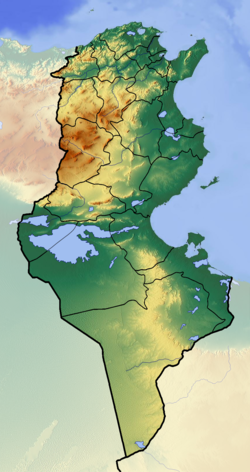The Chenini Member is a geological member of the Ain el Guettar Formation in Tunisia, whose strata date back to the Late Aptian to Early Albian stages of the Cretaceous period.[1][2] The lithology consists of coarse sandstones with occasional conglomerates and mudstones.[3] Dinosaur remains are among the fossils that have been recovered from the formation.[4]
| Chenini Member | |
|---|---|
| Stratigraphic range: Late Aptian-Early Albian ~ | |
| Type | Member |
| Unit of | Aïn el Guettar Formation |
| Underlies | Oum ed Diab Member |
| Overlies | Douiret Formation |
| Lithology | |
| Primary | Sandstone |
| Other | Conglomerate, mudstone |
| Location | |
| Location | Sahara Desert |
| Coordinates | 33°12′N 10°18′E / 33.2°N 10.3°E |
| Approximate paleocoordinates | 15°54′N 10°18′E / 15.9°N 10.3°E |
| Region | Tataouine |
| Country | |
| Type section | |
| Named for | Chenini |
Vertebrate paleofauna
editThe Chenini Member during the Early Cretaceous period was a marsh-like swampy habitat. The most famous dinosaur discoveries made here include Carcharodontosaurus and Spinosaurus.
| Theropods of the Chenini member | |||||
|---|---|---|---|---|---|
| Genus | Species | Location | Material | Notes | Images |
| Spinosaurus[5] | S.cf. aegyptiacus | A spinosaurid theropod | |||
| Carcharodontosaurus[4] | C. saharicus | A carcharodontosaurid theropod | |||
| Sauropoda[4] | Sauropoda indet. | ||||
| Iguanodontia[4] | Iguanodontia indet. | ||||
| Pterosaurs of the Chenini member | |||||
|---|---|---|---|---|---|
| Genus | Species | Location | Material | Notes | Images |
| Ornithocheiridae | Ornithocheiridae indet.[6] | ||||
See also
editReferences
edit- ^ Bateun el Hmaima at Fossilworks.org
- ^ Bir Miteur, RH 45 at Fossilworks.org
- ^ Benton, Michael J.; Bouaziz, Samir; Buffetaut, Eric; Martill, David; Ouaja, Mohamed; Soussi, Mohamed; Trueman, Clive (April 2000). "Dinosaurs and other fossil vertebrates from fluvial deposits in the Lower Cretaceous of southern Tunisia" (PDF). Palaeogeography, Palaeoclimatology, Palaeoecology. 157 (3–4): 227–246. Bibcode:2000PPP...157..227B. doi:10.1016/s0031-0182(99)00167-4. ISSN 0031-0182.
- ^ a b c d Weishampel, David B; et al. (2004). "Dinosaur distribution (Early Cretaceous, Africa)." In: Weishampel, David B.; Dodson, Peter; and Osmólska, Halszka (eds.): The Dinosauria, 2nd, Berkeley: University of California Press. Pp. 571-573. ISBN 0-520-24209-2.
- ^ Buffetaut, E & Ouaja, M (2002) A new specimen of Spinosaurus (Dinosauria, Theropoda) from the Lower Cretaceous of Tunisia, with remarks on the evolutionary history of the Spinosauridae. Bulletin de la Société Géologique de France 173: 415–421. doi:10.2113/173.5.415
- ^ a b BENTON, M. J., BOUAZIZ, S., BUFFETAUT, E., MARTILL, D. M., OUAJA, M., SOUSSI, M. & TRUEMAN, C. (2000): Dinosaurs and other fossil vertebrates from fluvial deposits in the Lower Cretaceous of southern Tunisia. Palaeogeography, Palaeoclimatology, Palaeoecology, 157: 227–246.
Further reading
edit- S. Bouaziz, É. Buffetaut, M. Ghanmi, J.-J. Jaeger, M. Martin, J.-M. Mazin, and H. Tong. 1988. Nouvelles découvertes de vertébrés fossiles dans l'Albien du sud tunisien [New discoveries of fossil vertebrates in the Albian of southern Tunisia]. Bulletin de la Société Géologique de France, 8e série 4(2):335-339
- J. Le Loeuff, É. Buffetaut, G. Cuny, Y. Laurent, M. Ouaja, C. Souillat, D. Srarfi and H. Tong. 2000. Mesozoic continental vertebrates of Tunisia. 5th European Workshop on Vertebrate Palaeontology, Staatliches Museum für Naturkunde, Geowissenschaften Abteilung. Program. Abstracts. Excursion Guides 45
